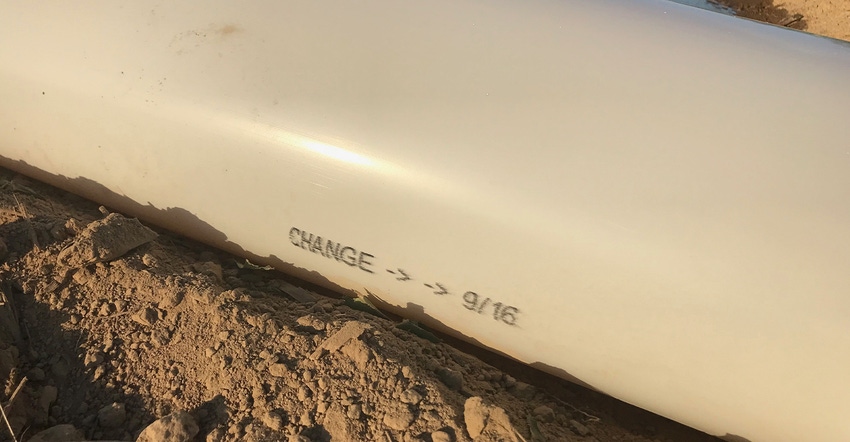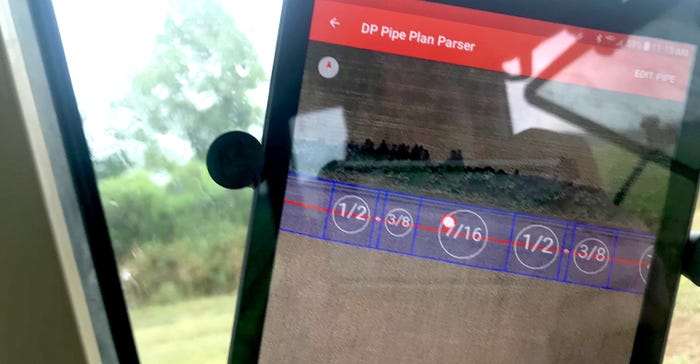December 26, 2019

Lay flat pipe has become increasingly popular in the South as a way to move water into flood irrigation areas. And the system is moving into other parts of the country where flood irrigation is used, due to the convenience of rolling out the material rather than using standard pipe setups.
A challenge with lay flat pipe, however, is managing water flow across the length of the pipe to make sure water is distributed more evenly. In the heart of Southern rice country, the University of Arkansas has come up with a system that offers a solution.
Chris Henry, an associate professor and water management engineer at the University of Arkansas, explains that lay flat pipe is commonly used in rice country, but is also increasingly used for other crops that get surface irrigation. The pipe is unrolled across the field; then, holes are punched in the single-use pipe to allow water to flow into the furrows between rows.
“You can adjust the amount of water that goes into a levee or [rice] paddy by varying the size of the hole punched,” Henry says. “At first, there was one size of puncher, but now there are hole punchers in a variety of sizes — from ¼-inch to 15/16-inch.”
With different hole sizes, it is possible to distribute water more evenly than if the entire pipe was punched with a single size; but how to manage that, and what’s the best arrangement to maximize water use?
“This is extremely low-pressure pipe, and if the holes are too small and there’s too much pressure buildup, it will burst,” he says. “Every year, you have to design the irrigation system again; it’s not like buying a pivot or micro-irrigation system and setting it up once."
 APP AT WORK: Working off a lay-flat-pipe punch plan, a printer system can link to GPS, so the system always knows where it is in the field to match flow to field location precisely. You can see the different hole punch sizes in the plan.
APP AT WORK: Working off a lay-flat-pipe punch plan, a printer system can link to GPS, so the system always knows where it is in the field to match flow to field location precisely. You can see the different hole punch sizes in the plan.

Enhancing the punch plan
Henry says most farmers are aware that punching the same-size hole across the length of the single-use pipe can create excessive water runoff. The aim is to get the flow rate proportioned to the row length, so that all furrows get the proportionate amount of water across the field.
There has long been an app from pipe makers like Delta Plastics that can help determine hole size across the field and print out a plan. The challenge is remembering where you are along the pipe to punch the appropriate-size hole. It’s not as simple as a smaller hole at the source and a large hole at the end. Hole size can go larger or smaller across the length of the pipe based on field shape and terrain, even in leveled fields.
“The challenge is implementing the plan,” Henry says. “You forget where you are, or are not sure of the hole-punch size in a given location.”
His solution? “We came up with a printer and four-wheeler system that prints the punch plan on the pipe as it is unrolled in the field,” Henry says. “We’re using an inkjet printer with insolvent ink, and we can identify where we are with GPS. The system pulls the punch plan off the app, recognizes the levee and prints that plan on the pipe three times on the pipe.”
Then, someone walking along the pipe can see the size and use the appropriate punch along the length. The system Henry has developed uses an onboard GPS antenna, and it can pull RTK from Trimble or a John Deere unit for increased precision. “We figured out how to produce the poly printer on the flat tile from the install roll,” he says. “With this system, we can put out 10 miles of pipe in a day.”
Farmers have long used the pipe planning app for appropriate hole size in lay flat pipe. “The pipe planner is helpful. Printing on the pipe makes a difference — you can see the punch plan,” he says.
Henry notes that the system was patented in October, and he’s currently looking for someone to license the system to sell to farmers.
About the Author(s)
You May Also Like






